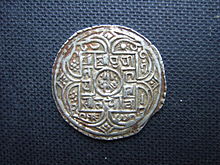
The Indian national calendar, called the Shaka calendar or Śaka calendar, is a solar calendar that is used alongside the Gregorian calendar by The Gazette of India, in news broadcasts by All India Radio, and in calendars and official communications issued by the Government of India.[1] Śaka Samvat is generally 78 years behind the Gregorian calendar, except from January–March, when it is behind by 79 years.
Through historical Indian influence, the Śaka calendar is also used in Java and Bali among Indonesian Hindus. Nyepi, the "Day of Silence", is a celebration of the Śaka new year in Bali. Nepal's Sambat evolved from the Śaka calendar. The Śaka calendar was also used in several areas in the modern-day Philippines as written in the Laguna copperplate inscription.
In India, Yugabda is also used with corresponding months of Śaka / Sambat. Yugabda is based on Kaliyuga Sankhya preserved by Indian astrology. The Kali Yuga began 5,125 years ago and has 426,875 years left as of 2024 CE.[2][3][a][4][b] Kali Yuga will end in the year 428,899 CE.
- ^ "Gg holiday calendar". india.gov.in (official website). Government of India.
- ^ a b c Godwin, Joscelyn (2011). Atlantis and the Cycles of Time: Prophecies, traditions, and occult revelations. Rochester, VT: Inner Traditions. pp. 300–301. ISBN 9781594778575 – via Google books.
- ^ Doniger, Wendy; Hawley, John Stratton, eds. (1999). "Hinduism / Yuga". Merriam-Webster's Encyclopedia of World Religions. Merriam-Webster. pp. 445 (Hinduism), 1159 (Yuga). ISBN 0877790442 – via archive.org.
- ^ a b
Gupta, S.V. (2010). "§ 1.2.4 Time measurements". In Hull, Robert; Osgood, Richard M., Jr.; Parisi, Jurgen; Warlimont, Hans (eds.). Units of Measurement: Past, present, and future: International System of Units. Springer Series in Materials Science. Vol. 122. Springer. pp. 6–8. ISBN 9783642007378.
{{cite book}}: CS1 maint: multiple names: editors list (link)
Cite error: There are <ref group=lower-alpha> tags or {{efn}} templates on this page, but the references will not show without a {{reflist|group=lower-alpha}} template or {{notelist}} template (see the help page).